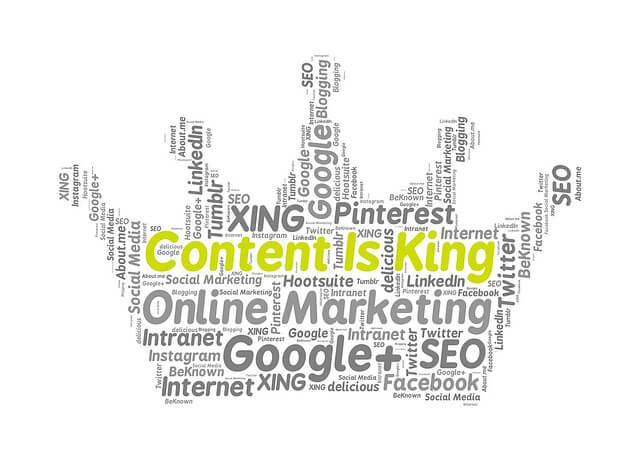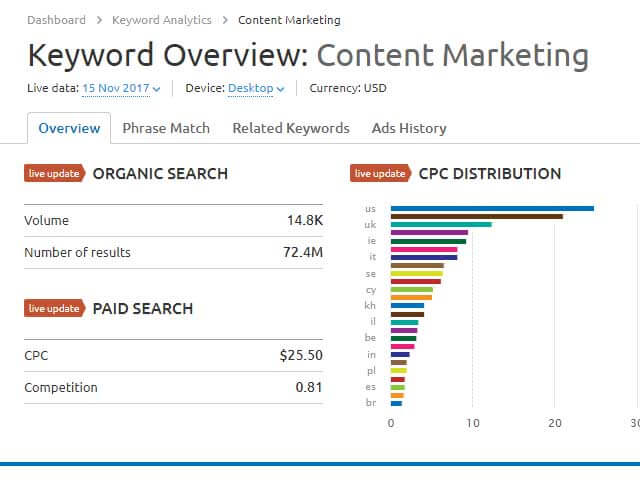When you engage in content marketing, you’re not just creating demand for a new need.
You’re also creating and distributing relevant, consistent and valuable content to attract and engage a targeted audience.
In other words, content marketing is a matter of anticipating and meeting an existing customer need for information.
Your business can use it to:
- Generate or increase online sales
- Appeal to potential leads
- Engage an online user community
- Increase brand credibility or awareness
- Expand customer reach

Done right, content marketing can boost your sales efforts by enhancing trust and rapport with your target audience.
Since content marketing focuses on the needs of the customer, your business should use the most effective format to deliver information to your customers. Some types of content include infographics, e-books, photos, blogs, Q&A articles, how-to guides, podcasts, video, news and email newsletters, among others.
What is a content marketing strategy?
If you want to grow your business, it’s important to have a well-thought-out content marketing strategy.
Simply put, a content marketing strategy is a blueprint for how you will build an audience that will build your business.
Benefits of Content Marketing

Content marketing benefits your business in the following ways.
1. Improved SEO
In the past, you can rank a 300-word article using spammy keyword stuffing tactics. Not anymore. Google is constantly improving their algorithm to provide a better experience for their users. It’s now harder — impossible, even — to rank your website with low-quality content.
That’s why it’s important to focus on quality. The more high-quality content you produce, the more Google rewards you with higher search engine rankings. As such, effective content marketing is a no-brainer when improving on-site SEO.
2. More Leads
By giving out valuable information that helps customers make a purchasing decision, you establish trust and credibility. In time, this helps attract quality prospects to your business.
3. Increased Traffic

When crafting quality content, it’s important to sprinkle keywords throughout. The more you do this, the more keywords you can index, and the more people will likely find your business.
By doing this, you build brand awareness. If readers enjoy your content, they’ll keep coming back to you. The key is to be consistent. Deliver great content every time, and you’ll have great feedback from customers in return.
4. More Sales
Great content helps boost your conversion rate, which translates to more sales for your business. With more and more people using ad blockers on their browsers, content is the best format for marketing to visitors without disrupting their experience on your site.
5. Increased Brand Awareness
If you want more people to know about your business, content is key. By producing high-quality content on a regular basis, you position yourself as a trusted authority in your field. And, as you know, trust is the new marketing currency.
6. Improved Customer Relationships
Customers don’t like being marketed to, especially if they think your product doesn’t have any “real” value for them. But if they see you as an expert in your field, and you show that you care more about delivering value to them (through content) than sucking their wallets dry, they’re more likely to feel comfortable doing business with you.
7. More (Filled) Seats
If you drive sales through webinars or in-person events, marketing your business through high-quality content can be a good way to fill seats. You can use landing pages, web banner ads, email, social posts, testimonial videos and other types of content to raise awareness of the event.
How To Develop a Content Marketing Strategy

According to the Content Marketing Institute, 70% of B2B marketers said they’re creating more content this year than before. This means you’re not the only one who sees the value of good content.
Luckily, you can still get ahead of the pack by formulating a smart content marketing strategy as follows.
1. Define your goals.
“A man without a goal is like a ship without a rudder.” – Thomas Carlyle
Before creating a content marketing plan, ask yourself these questions.
- Which audience are you creating the content for?
- What problem are you going to solve?
- How unique is your content?
- What formats do you intend to use?
- What publishing channels do you intend to use?
- What kind of schedule are you going to follow to manage content creation through to publishing?
By answering these questions, you’ll find it easier to formulate clear goals. The clearer your goals, the more likely you can create a content marketing plan that’s in line with (and can successfully accomplish) those goals.
2. Define your target audience.
Your audience is arguably the most important piece of the content marketing puzzle. When you know who you’re supposed to be marketing to, it’s easier to focus your efforts and allocate your resources accordingly.
For example, if you’re marketing real estate to young professionals, you’ll want to emphasize the “cool” aspects of your property. On the other hand, if you’re marketing to 60-somethings, you’ll want to give them reasons why your property is a great place to spend their retirement days.
Of course, different individuals within the same demographic can have different preferences. The key is to find at least a handful of pain points that those individuals share, and position yourself as a solution to those pain points.
3. Brainstorm content ideas.

There are plenty of ways to generate content ideas. For starters, you can ask yourself the following questions.
- a) Is there any topic in your industry that hasn’t been covered before?
- b) If a topic has been done to death, how can you put your own spin on it?
- c) What content type best fits the topic you have in mind?
4. Do your (keyword) research.

Before creating content, you’ll want to find out what people are searching online. Knowing that, it’ll be easier to determine what type of content they need, and how you can meet that need.
In other words, you want to know what keywords they’re searching. Essentially, keywords are what people type into the search bar on Google. For example, if a user is looking for property in New Orleans, they will type “property in New Orleans.”
Sometimes, they’ll want something more specific. If they’re pet owners, they’ll look up something like “pet-friendly properties in New Orleans.”
When people type keywords into the search bar, Google generates what it “thinks” are the most relevant results. People typically won’t look beyond the second (or even first!) page of those results, so your goal is to rank as high as possible for the keywords relevant to your niche.
That’s where keyword research comes in. Here’s how you do it:
Start with what you know.
What are the core terms that your target audience is likely searching for? What would you search for if you wanted information in your niche?
Once you have a list of your basic keywords, it’s now time to generate additional insights. To do that, you can use free keyword research tools such as Soovle, Bulk Suggest, and Google Keyword Planner. You may also use Google Trends to see what is trending in your niche.
Go niche.
It’s more difficult to rank for “property management” in general than “property management in New York.” Likewise, you’re better off ranking for “pet-friendly properties in North Carolina” than for “properties in North Carolina.”
Of course, you want to make sure your niche is something people are actually looking for. The key is to evaluate whether your ultra-specific keyword can work on a local level, at the very least.
Spy on your competitors.
Alternatively, instead of putting together a keyword research strategy from scratch, you can check what your competitors are doing. If they’re ranking well in the SERPs, it’s likely that they have a solid keyword research strategy.
One tool to help you size up competitor rankings is Serpstat. With this, you can simply copy and paste the domain URL of your competitor into the search box and wait for their stats to load.
Don’t forget to optimize your keywords.
Once you’re done with your keyword research, your next step is to optimize your content.
Sprinkle your keywords strategically throughout your content. Ideally, you should use your keywords and its variations in:
- The page title and headline
- The URL
- The first paragraph of the article
- The subheadings within the article
Make sure the keywords are integrated naturally into the content. Also, avoid “overstuffing” your content with the keywords. Otherwise, Google might penalize your site.
5. Choose your content type.
As mentioned earlier, the format in which you’ll deliver your content is crucial. Below are a few of those formats.
Blog Posts

Blog posts are the most straightforward type of content. They usually come in the form of text, though you can also add an image or two to break up the whole thing. In general, it’s better to write posts that are at least 1,000 words long, since Google prefers long-form content.
Infographics
Infographics work best when you want to share a ton of data in a concise, visual format. Fortunately, you can generate these using both free and paid tools available online.
E-books
Compared to blog posts, e-books provide more in-depth information on a topic. You can use them as a lead generation tool for your business. All you have to do is set up a lead capture form on your website, and allow people to download your e-book in exchange for their email. That’s what we’ve done on our homepage!
Videos
Videos are arguably the most engaging type of content. According to Hubspot, videos are 40 times more likely to be shared on social media than any other content format.
Keep in mind that videos take a lot of time to create. If you want to put up a video or two, consider hiring a professional video editor to help you.
Podcasts
Podcasts are the go-to format for people who prefer audio content, or for those who like to consume content and do other things at the same time. One study by Edison Research suggests that more and more people prefer this format, with close to 60 million tuning in to podcasts every month.
6. Create content for every step of the buyer’s journey.

To develop an effective content marketing strategy, it’s essential that you know the four stages of the buyer’s journey.
Awareness
At this stage, the buyer discovers they have a problem that needs to be solved.
Interest
The buyer searches for a solution to the problem.
Decision
The buyer now has a handful of possible solutions. All they have to do is choose which one they think is best for them.
Action
The buyer makes the purchase (hopefully from you!).
Each of these stages requires a different type of content. You can find more information on optimizing content for each step of the buyer’s journey here.
7. Promote, promote, promote.

Content marketing doesn’t end when you hit the “Publish” button. Once you’ve posted your content, you need to promote it as much, and as well, as you can.
Share your content with your customers, your email list, and on social media. Reach out to industry influencers in your niche. Run a Facebook ads campaign to make your content more visible. Do whatever it takes to attract eyeballs to your content.
8. Consider repurposing content.
In an ideal world, every piece of content you produce will be “unique” in the strictest sense of the word. But when you’ve produced enough content, you realize that there are only so many ways to write about the “Top 10 Neighborhoods In (Your Area).”
When that happens, you’ll want to switch gears. Instead of producing only blog posts, for example, you can also host podcasts, stream videos and share slideshows. After all, most people are visual beings, so they’ll definitely appreciate content that’s easier on the eyes.
9. Have a content management system in place.
Content management systems include WordPress, Magento, Drupal, and Joomla. All of these are helpful for managing content creation, publication and analytics.
Remember to do your research before using any of these. Each of them has its pros and cons depending on your overall content marketing strategy.
You’re now equipped with everything you need to know to get started with your content marketing. Granted, creating an effective strategy takes a lot of hard work, time, and dedication. But if you stick with it long enough, your content marketing will boost your bottom line and then some.



